Sound on its own was obviously deemed insufficient for the latest concert by the BBC Symphony Orchestra, here under its Principal Guest Conductor, Dalia Stasevska. A clear case of “Let there be light!”: floodlights and neon bars, magenta and turquoise for the opening piece, with the addition of vibrant orange for the rest of the first half, and then cold icy-blues for a Nordic symphony. The logical extension of this is surely to require sartorial changes for the musicians on stage. Why stop at charcoal grey for everybody?
Such distractions apart, the festive mood was enhanced with an opening piece by Iain Farrington called A Party with Auntie, written to celebrate the formation of the British Broadcasting Company on the 18th October 1922. The BBC Symphony, which itself grew out of what was initially called the Wireless Orchestra, demonstrated its versatility by moving into Big Band and Swing territory. This was high-voltage stuff, the theme tunes inter alia for The Antiques Road Show and Match of the Day peeping their heads above a glossy, shiny exterior, the lower brass braying for dear life.
Dai Fujikura’s Glorious Clouds derives its inspiration from microbiomes, the idea that small micro-organisms make up the entire world and that this is, in the composer’s view, reflected in the sounds of the orchestra. There is a conceptual problem here: clouds can indeed float freely, and are visible, frequently changing shape and definition, whereas the operation of the human gut is hidden from view. Fujikura’s piece provided opportunities to admire the technique: orchestral trilling, subterranean burrowing from the lower strings, flutter-tonguing, bongo drums presaging the arrival of a thunderstorm and an overall texture characterised by shimmering luminescence. Though there were subtle changes in dynamics, what the work lacked was variation in pulse. It was like watching a huge ocean-going liner gliding through the night.

From its opening solo recitative, the cello commands attention in Elgar’s Cello Concerto in E minor. Yet heroism on its own is not enough, for in the four-movement structure this instrument passes through a vast range of moods and colours. Two things stood out for me in this absorbing and richly detailed performance by Sol Gabetta. There was her trademark deep and earthy tone coupled with an extraordinary control over dynamic shadings, especially in the gossamer lightness of the Allegro molto section of the second movement. What made it all so very special though was her eloquent soulfulness, the sentiment never over-indulged, the nobility of this elegiac work masterfully underlined. Stasevska and her BBC players provided sterling support.
If there is one thing that Stasevska is particularly good at, it is the ability to release huge reservoirs of energy in an elemental work like Sibelius’ Symphony no. 1 in E minor. She rode the rhythmic surges of the opening movement with great intakes of breath, the lungs rapidly filling with highly-oxygenated particles of air, the upper strings contributing a sharp cutting edge, icy trumpets chilling the bone to the marrow, the lower brass terrifyingly ferocious.
Elsewhere in this symphony she favoured strong contrasts. At the start of the Andante the prominence given to the harp was like the tolling of a bell prior to prayer, the following grand string theme echoing the elegiac quality present in the earlier concerto. There was a Beethovenian-like ruggedness to the Scherzo with impressive rhythmic articulation, the much slower Trio section graced by a deliciously floated flute solo and languorous bassoons. If Stasevska’s tendency to give in to all the full-blooded Romanticism of the Finale led to some loss in nobility, this was altogether stirring, bracing stuff.


